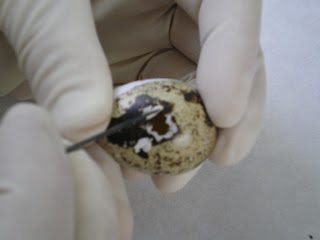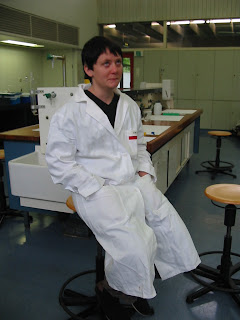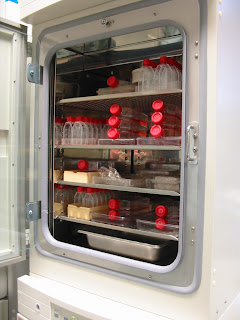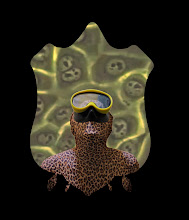A few days after meeting with Prof Berkout I sent a follow up email confirming my interest in the possibility of working with some T-Cells in the Laboratory. As I expected, he replied to say that as they did not have the specific cells I was wanting to work with, nor the time and space to give me the appropriate training to work in their Labs that he was unable to provide me with Lab access.
The hunt continues...
Sunday 27 May 2007
A&G Centre: Micro-surgery 101
























May 11 2007: Adam Zaretsky Embryology Session, Leiden University.
Eden St James was kind enough to photograph the experience.
I was assigned a phesant egg, with a three day old embryo inside. This egg had a name. It was called material.
Rationale: Perform micro-surgery on the embryo, using
a)Microsurgical tools to modify the form
b)acid to modify the growth
c) growth mutating plasmid
I chose micro-surgical tools only.
The idea of performing Micro-surgery on an embryo really made me feel physically ill. I was struggling with the idea of going through with it, and very nearly didn't. So I felt as someone who inadvertently uses animal products in a Lab, even when I am growing tissue, I should address the fact of this head on and actively engage with and take responsibility for it, instead of just ignoring it,or putting it down to necessity as I suppose I have been doing. Its very easy to sideline it if its a generic coloured liquid in a generic coloured bottle - not so when its actally an animal form. Bio-tech is really scary. Exciting and horrible at the same time. As I began the process of locating and positioning the embryo, opening the 'window' in the egg shell and creating my micro-surgical glass tools I felt all my emotions - adrenelan/intrigue/excitement/power/fantasy all conflicting inside me, and overall the excitiment overcame the hesitation. The experience was very powerful and the act of being there in that moment really overtook from my conceptualising about what I was actually doing, and why. It was such a rush, like wow, creating a new life form - I can really understand how ethics goes out the window. I think its like that often with wet science, you lose track of yourself amongst the labcoat and coloured bottles and material and this idea of engaging with 'life' or creation takes over.
I think also because the embryo was only three days old when you view it inside the egg, even under the microscope, its very hard to tell what you are looking at, which makes the disassociation stronger.
In the end though i really did feel i'll, and topped the whole experience off by going outside and eating a boiled chicken egg I had brought with me. Sophie also took a video of me doing this. It was really unplesant.
I'm glad I did it though. It reminds me to keep engaged with what i'm doing and working with, to keep a check on my self and to be aware of the lures of the Lab-lust; to keep questioning and reminding myself what my goal is in working in this realm anyhow.
On the flip side, it turned out to be a little SymbioticA reunion, as Shawn and Jen from Bioteknica turned up, and Cynthia Verspaget and her Adam dropped in on their way from the Portugal Bioart show, all of whom were at Symbi when I was there. Random goodness!
Sex postitve performance artists Zootengenant (http://www.zootengenant.com) also came along to film the class. They had requested we all bring a sperm sample to class, and were going to do a performance in which Jeanette would do a handstand naked while Zoot levitated eggs with insense, but needless to say there was no levitation, so instead Jeanette gave Adam a sperm-horoscope reading. So the class also had some other happenings happening, beginning with one of the students taking magic mushrooms as an 'assignment', and a bunch of the students leaving to masturbate as ve=arious points, to produce the sperm sample, while Jeanette videotaped them.
Monday 14 May 2007
A&G Centre HIV Project - Lot de Witte

Tuesday 15 May Eden and I met with Lot de Witte, a PhD researcher at the Vrije University's Medical Centre (VUMC). After a lot of fooling around with directions (as I seem to be experiencing a lot in this counrty) we arrived 1 hour late and had to reschedule to the next afternoon. When we finally met Lot was very forward in asking us what we were wnting from the project, and was extremely helpful in providing us with a lot of information and visual imagery of the virus.
A&G Centre - Zoo visit and animal enrichment installation - Adam Zaretsky





On May 4th I was invited to join Adam Zaretsky's class on their visit to the Amsterdam Zoo (Artis). Zaretsky is an American Bioartist who I met last year at the SLSA Conference in Amsterdam, who is here as guest lecturer at the A&G Centre for 6 weeks. He's giving his Vivoarts class, which delves into Ecology and EcoArt, Gastronomy and Edible Art, Biology and Bio-Art,
Ethology and Art for Non-humans, Physiology and Body Art and involves a couple of hands on Lab classes. So I think i'll tag along on next weeks class too...
First we had a lecture by one of their P.R people/staff on animal life in the zoo and a little on their animal enrichment strategies, which were really surprisingly poor and unimaginative. I don't know how many Zoos have an animal enrichment program - maybe it's quite a new thing, but I really don't see how throwing a road works witch's hat into the polar bear pen counts as a legitimate form of animal enrichment! I think they seriously need some creative people on their team. We also got to go behind the scenes with one of the zookeepers, and see the little concrete pens where the animals sleep, as well as see their freezers full of a whole assortment of frozen animals (food). It was like a cross between a butchers and a museum in there - so many different kinds of rodents etc...as well as skinned things like chickens. Mostly the tigers just live off a whole cow carcass which is thrown in the pen every three days.
The focus of the class was really on animal enrichment, so our main activity was to create a contraption from bunji cord and random animal toys etc, including a trampoline, that could go into one of the animal enclosures for the nanimals to play with - see below. I think we kind of freaked out the zoo staff, and they didn't put the crazy contraption into any enclosure, but they said they'd modify it and get back to us....Hah. I wonder.
A&G Centre HIV Project 3. Prof Ben Berkhout: AMC AIDS Laboratories






Wednesday 25th of April I had a meeting with Prof Ben Berkhout at the University of Amsterdam's Medical Centre (AMC), Immunology Department.
Berkhout is a molecular biologist working directly with the complete HIV virus, unlike many researchers who may actually deal with only one component of the virus such as a particular protein etc. He gave me some up to date information on the innovative research they are doing on the virus using a live virus as a vaccine. They have developed a virus which can be turned on and off by using an antibiotic as a trigger. They'll be testing this on macaws in the near future. He also showed me some recent research on the visulaisation of the virus, a couple of websites: www.nature.com/nature/journal/v441/n7095/full/nature04817.html
They have deciphered the shape of a particular protein in HIV 1 which takes on the stable form of a tripod like structure. It interesting to find out that they do not even know what the virus itself really looks like internally, and this kind of visual research is still somewhat in its infancy, due to the minute size of the virus itself.
I was also lucky enough to gain access to their BSL3 (Biological Safety Level 3) Aids Lab. Rienk Jeeninga (pictured) gave me the tour.
A&G Centre HIV Project 2
Meanwhile, Soph and I have both been brainstorming our visions for the visual format we want this work to take, and have decided definitely on an animation and some sculptural works. For my part of the animation i've been working on some ink drawings, very kind of cutesy/spooky and colourful - they have a naive and fun feel about them. Sophie is planning to make some sculptural pieses to animate, and is thinking about wax at the moment. So through our brainstorming we decided that the approach we wanted to take is one which focuses upon the virus itself as a rogue, hybrid entity, one that came out of an enexpected meeting between humans and animals, and continues to be a kind of mutating, shape shifting parasite. I've been working a lot with strange organisms in my own work, so its perfect for me really, and also carries on from what i'm doing in my PhD work. I fell in love with the cordyceps fungi when I first saw it on David Attenborough's This Planet Earth, Jungle, or was it Forests episode? Anyhow it's a pretty amazing organism. Basically, it releases it's spores into the atmosphere, which get attached to the body of an insect. These spores then begin the infect the insects body and mind and brainwash the insect to move upwards, along branches or whatever plant may be near by. By the time it is far enough of the ground it clings to whatever surface it is on, giving it a firm grounding. Then slowly the fungus enteres the ants body, gradually replacing the ant's tissue with it's own, until it has completely overtaken its body, at which point it bursts out of the insects body like an alien, and it's beautiful fungi forms continues to grow upward out of the corpse. It's pretty amazing, and the process is visually stunning too. I managed to download the video online, and it's on my myspace video section.Other organisms we've been thinking about are the camilien - for obvious reasons, and a lot of other parasites. We've also been delving into the fictional parasites and creatures, including the nine tailed shape shifting fox. I'm not sure that fictional is way to go though. Perhaps its best if we use real organisms, but portary them in an illusory manner, so you'd assume they were fictional, but then realise they actually exist. I'm not sure though, I don't seem to be able to tear myself away from my blobby fluid haluncinatory creatures, and i've been working on some characters and organisms for my PhD submission for some time now, and I really don't want them to overlap too much. So it will be a challenge. Parasitic plants are a big interest too. I find them incredibly curious, because often they look nothing like their host, and are much more beautiful also - so I don't really undertsand how thay work and why they dont camoflague with their host at all. I mean I know its different to animals which camoflague to hide from predators, but I am wondering why the parasitic flowers/plants are so different from their hosts to begin with. I guess it makes sense though if they use their difference and beauty as an easy way of attracting birds and insects to carry their pollen to other trees and high places...
A&G Centre HIV Project 1
Okay so i figure this kind of blog is a great way to chart the process of my laboratory projects, especially seeing they are becoming more long term, and there'll be periods where there's not much going on with them, and i wont be making note anywhere of whats actually happening, or not happening as may be the case.So: Right now I am in Amsterdam. I'm in contact with HIV research scientists, mostly molecular biologists. The first point of contact was Rafael Van den Bergh from the Department of Cellular and Molecular Immunology (CMIM) Flanders Interuniversity Institute for Biotechnology (VIB), Vrije Universiteit Brussel (VUB), Building E, room E8.07, Pleinlaan 2 , B1050 Brussels, Belgium, tel. +32-2-629.19.77, mobile +32-472-65.44.02, email rvdbergh@vub.ac.be. He was found through Sophie, via a woman at UCD (Dublin), and he's been really helpful in giving us the heads up on the current state of research with the virus, and what may and may not be possible with our project. The second point of contact was Prof Dr. Ben Berkhout, from the Laboratory of Experimental Virology, Department of Medical Microbiology, Center for Infection and Immunity Amsterdam (CINIMA), Academic Medical Center of the University of Amsterdam.After a lenghty wait for his reply, he's not sure he can be of much help, but is happy to meet with me, so I will make an appointment through his secretary, and see what happens. The Thrid contace it Lot de Witte, a PhD researcher at the Vrije University Medical Centre, who is doing HIV research which includes visual imaging. She seems quite excitied about the project, and I have a good feeling about her. She is keen to meet and talk about both mine and her research, and has passed my email on to her supervisor, Theo Geijtenbeek, so will wait and see if he contacts me also.We are very interested in any kind of visual imagery relating to the virus itself, and expected there would be some kind of moving footage available, from an electron microscope/video camera with microscopic lense attachments, however Rafael says he has never heard of anything like this. It's strange because I know at SymbioticA they get time lapse footage of cells in action using this technique at their Image Analysis and Aquisition Facility (IAAF). So hopefully the imaging team at Vrije Uni will know more about this.
Subscribe to:
Posts (Atom)
